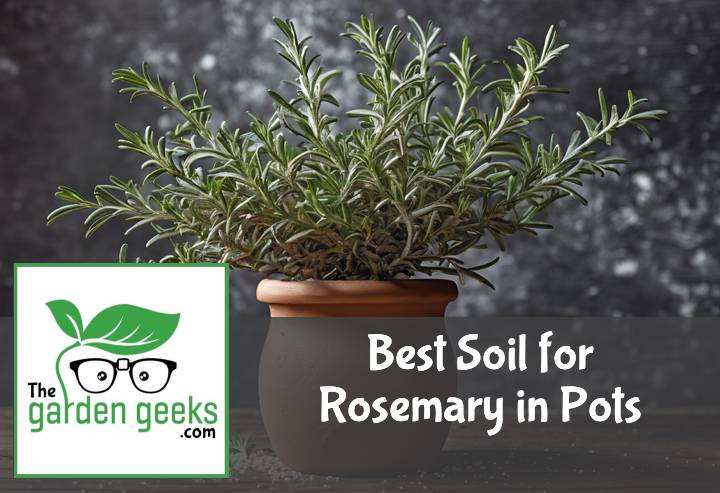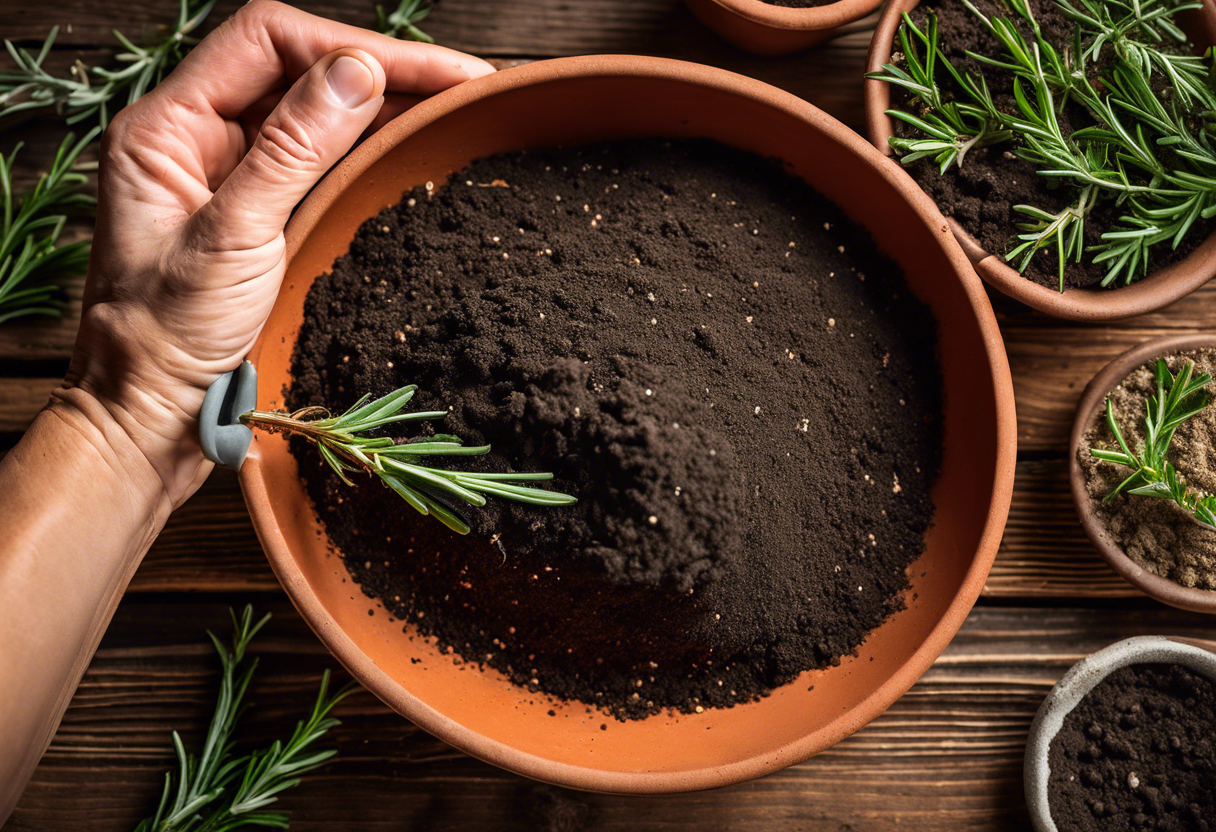Ever tried growing rosemary and ended up with a wilted, sad-looking plant? Trust me, I’ve been there. It’s not the lack of a green thumb, it’s all about the soil! Yep, you heard it right. The Best Soil for Rosemary in Pots can make or break your herb gardening game.
Rosemary is a bit picky when it comes to its living conditions. It needs just the right mix of nutrients, pH levels and drainage capabilities. But don’t worry, we’re going to dive deep into this topic and by the end of this post, you’ll be a pro at picking out the perfect potting mix for your potted rosemary.
Keep reading about Best Soil for Rosemary in Pots (Best Potting Mix).
Key Takeaways
- The best soil for rosemary in pots is well-draining, sandy or loamy soil with a pH between 6.0 and 7.0.
- A good potting mix includes one part perlite or sand, one part garden soil, and one part peat moss or compost.
- Overwatering can lead to root rot; ensure the pot has drainage holes.
- Regularly check the soil’s moisture levels; it should be dry before watering again.
- Fertilize every 4-6 weeks during growing season with a balanced fertilizer.
Understanding Rosemary Plant Needs
Rosemary plants are like the divas of the herb world. They love their sunlight, can’t stand the cold, and need just the right amount of water. Rosemary plant care isn’t rocket science, but it does require a bit of attention.
The Importance of Proper Soil for Rosemary
Now let’s talk about soil. It’s not just dirt, folks! For rosemary, it’s all about drainage and pH level. These plants hate having wet feet. So, a well-draining soil is crucial to prevent root rot.
Next up is pH level. Rosemary prefers a slightly acidic to neutral pH range (6.0-7.0). Too alkaline or too acidic can hinder nutrient absorption.
Speaking of nutrients, rosemary isn’t too picky but does appreciate a good feed now and then. A soil rich in organic matter will keep your rosemary happy and healthy.
In short, choosing the best soil for rosemary is like picking out the perfect pair of shoes – it needs to fit just right!
Specific Needs of Rosemary in Pots
When you’re growing rosemary in pots, things get a bit more complicated. The pot size matters – bigger is usually better to accommodate those sprawling roots.
The type of potting mix also changes the game. Regular garden soil won’t cut it here; you’ll need a special potting mix for rosemary that ensures proper drainage and nutrient balance.
Remember folks, container gardening with rosemary isn’t hard; it just requires some thought into selecting the right pot and best soil for rosemary in pots!
What Makes a Good Potting Mix for Rosemary?
The best potting mix for rosemary is one that checks all the right boxes. It should have excellent drainage capabilities, be rich in nutrients, and maintain an ideal pH level. These are the key rosemary soil requirements that can make or break your rosemary’s growth when growing rosemary in pots.
Drainage Capabilities
Rosemary is not a fan of wet feet. It prefers soil that drains well to prevent root rot. The importance of soil drainage for rosemary cannot be overstated.
A good potting mix will ensure this by being light and porous. This allows excess water to escape easily, providing the best draining soil for rosemary.
Nutrient Content
Rosemary needs a nutrient-rich environment to thrive. The best potting mix will cater to these needs by being rich in essential nutrients.
These nutrients help support healthy growth and development, making it crucial to choose a nutrient-rich soil for rosemary.
In addition to watering, feeding your potted rosemary with a nutrient-packed potting mix can make all the difference!
pH Level
Rosemary prefers slightly alkaline conditions, with an ideal pH level between 6 and 7.5.
Choosing the right potting mix can help maintain this balance, as some mixes are specifically designed to adjust and hold pH levels within this range.
So there you have it! The secret sauce behind the best soil for Rosemary in pots lies in its drainage capabilities, nutrient content, and pH level!
Best Types of Soil for Potted Rosemary
Choosing the right soil is crucial for your potted rosemary. It’s like picking a comfy bed for your plant baby! Rosemary potting soil should be well-draining and nutrient-rich. Commercial mixes and DIY recipes can both work wonders, depending on your green thumb skills and patience.
Commercial Potting Mixes Suitable for Rosemary
When it comes to commercial potting mixes, there are several options that can make your rosemary thrive. These pre-made solutions are convenient, especially if you’re new to the indoor rosemary plant care game.
However, not all store-bought soils are created equal. Some might be too dense or lack essential nutrients. That’s why it’s important to choose a suitable potting mix for rosemary, one that meets its specific soil requirements.
One popular choice is a cactus or succulent mix. It offers excellent drainage – just what our Mediterranean friend loves! But remember, even the best commercial soil for rosemary needs occasional fertilizing to replenish nutrients.
DIY Potting Mix Recipes for Rosemary
If you’re more of a hands-on gardener, making your own potting mix can be rewarding. Plus, you get to control exactly what goes into your homemade soil for rosemary.
A simple recipe involves mixing equal parts compost, coarse sand, and perlite or pumice. This blend mimics the natural environment of rosemary and provides excellent drainage.
Another option is to use sterilized garden soil instead of compost. Just remember to add some organic matter (like worm castings) to boost nutrients in this custom soil blend for herbs.
Creating an organic homemade potting mix isn’t rocket science but does require some trial and error. So don’t fret if your first batch isn’t perfect – Rome wasn’t built in a day, and neither is the best soil for rosemary in pots!
How to Prepare and Use the Potting Mix
When it comes to growing rosemary, getting your hands dirty with rosemary potting mix preparation is a must. It’s not just about throwing seeds into a pot. The real magic lies in the soil selection for rosemary, planting process, and ongoing care.
Preparing the Pot and Soil
First things first, you gotta get that pot ready for your rosemary. You’re looking for something with good drainage because nobody likes soggy roots! Now let’s talk dirt. When selecting soil for rosemary, think Goldilocks – not too acidic, not too alkaline. We’re aiming for an ideal pH for rosemary soil around 6-7.
But wait, there’s more! Your soil needs to be nutrient-rich too. Think of it as a buffet for your herbs – plenty of food means happy plants!
Planting the Rosemary
Alrighty then! You’ve got your perfect pot and super soil. Time to plant that baby! When planting rosemary in pots, choosing healthy seedlings is key. Look out for vibrant green leaves and sturdy stems.
Next up is positioning of rosemary in pots. Place your plant in the center of the pot to give it room to grow and spread its roots far and wide.
Ongoing Care and Maintenance
Congrats! You’ve successfully planted your rosemary but hold up – we’re not done yet! Caring for potted rosemary plants requires some TLC post-planting too.
Watering schedule? Check! Sunlight needs? Double check! Rosemary loves a good sunbath so find a sunny spot in your home or garden.
And don’t forget about pruning techniques. A little trim here and there helps keep your plant healthy and bushy – just how we like our herbs!
Common Mistakes to Avoid When Choosing Soil for Potted Rosemary
When it comes to potted rosemary care, there are a few common slip-ups that can turn your fragrant herb into a wilting mess. One of the biggies is over-watering, but using unbalanced soil can also spell disaster. Let’s dive into these rosemary plant mistakes and learn how to avoid them.
Over-watering and Poor Drainage
Over-watering your potted rosemary is like giving it a one-way ticket to root rot city. The roots become waterlogged, leading to a soggy, unhealthy plant. Not exactly what you want when you’re trying to grow this Mediterranean beauty!
Poor drainage compounds the problem. If your pot doesn’t allow excess water to escape, you end up with a waterlogged rosemary pot. It’s like forcing your plant to wear wet socks all day – not fun!
The solution? Be mindful of watering and choose pots with good drainage holes. This way, you’re preventing overwatering in potted plants and ensuring they have the right conditions to thrive.
Using Unbalanced or Nutrient-poor Soil
Just as important as water is the soil you choose for your potted rosemary. Using unbalanced or nutrient-poor soil is like sending your plant on an extreme diet – it won’t get the nutrients it needs to grow strong and healthy.
Unbalanced soil can lead to nutrient deficiencies in your potted plants, making them weak and susceptible to disease. And let’s face it, nobody wants a sickly looking rosemary!
To rectify this problem, consider enriching your potting mix with organic matter or slow-release fertilizers. This will improve the soil balance and provide essential nutrients for your rosemary plant.
Remember folks, choosing the best soil for rosemary in pots isn’t rocket science. It’s all about providing the right conditions for your plant to flourish. Avoid these common mistakes, and you’ll be well on your way to growing a thriving rosemary plant!
To Wrap Up
So, we’ve dug deep into the world of potting mix and unearthed some golden nuggets about the Best Soil for Rosemary in Pots. Just like a goldfish needs the right bowl, your rosemary needs the perfect soil to thrive!
Don’t be a stranger to good potting practices! Now that you’re armed with this knowledge, go ahead and give your rosemary plant an upgrade it truly deserves. Happy gardening!





